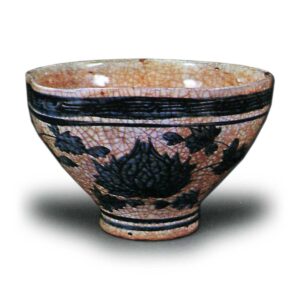
Goroshichi, whose family name was Takahara, was also made into Takehara. Goroshichi was a prominent figure in the history of Japanese porcelain, and was once considered the founder of Japanese porcelain. According to the records of the Sakaida family in Arita, Saga Prefecture, and the Imamura family in Mikawachi, Nagasaki Prefecture, Goroshichi was a Korean who came to Japan following Kiyomasa Kato and became a potter in the Toyotomi family. After the fall of Osaka, he went to Chikuzen Province (Fukuoka Prefecture), passed through Shiinomine in Hizen Province (Minamihata-cho, Imari City, Saga Prefecture), and came to Minamikawara (Magarukawa, Nishi-arita Town, Nishimatsuura County), where he taught pottery techniques to Kakiemon Sakaida. Later, he left there and moved to Ureshino Uchinoyama (Ureshino-machi, Fujitsu-gun), and then to Arita Iwaya-gawauchi (Arita-machi, Nishimatsuura-gun), where he fired celadon and other fine wares. During the Kan’ei period (1624-44), the prohibition of Christianity became severe, and Goroshichi was suspected of being a Christian, but he disappeared before he could be arrested. Goroshichi is said to have gone to Tosa Province (Kochi Prefecture), returned to Osaka, and died of illness in Tenma. Goroshichi’s eccentricities in Kyushu are legendary, and his strange behavior and strange words and deeds further deepen his mystique. Goroshichi lived in Hizen for about 20 years during the Genna-Kan’ei period (1615-1444) and was constantly associated with the underglaze blue porcelain of the various Hizen kilns in the early days. However, there is no certainty of his posthumous work, and only the name Gorohachi Tea Bowl has been handed down. According to some people, Shozui Gorotayu had two disciples, Goroshichi and Gorohachi, and Takahara Goroshichi is said to be Shozui’s disciple. Gorohachi is said to be Gorohachi’s apprentice, and Gorohachi is said to be a transcription of Gorohachi, in other words, the same person. This theory that Shozui was a student of Goroshichi has been denied due to the significant discrepancy in chronology, but what if Shozui’s chronology is lowered by about 100 years, as in the recent theory of Ishimatsutaro? There is room for reconsideration. Although it is impossible to confirm that Goroshichi was a Christian, it is likely that his presence at Ureshino Uchinoyama may have contributed to his suspicion of Kirishitan. Fudo in Ureshino is famous as a hideout of the Amakusa remnants of the Kirishitan, and the Nabeshima family was very active in exterminating them, as detailed in “Hizen Yawa” (A Tale of Hizen). The site of an old kiln still stands there today. Heijiro Nakayama, a doctor of medicine at Kyushu University, published his research on Goroshichi’s history in Chikuzen in the “Archaeological Magazine” in April 1915 (Taisho 4). Rikizo Shiota’s “Study of Ceramic Crafts” also describes Goroshichi in detail.



